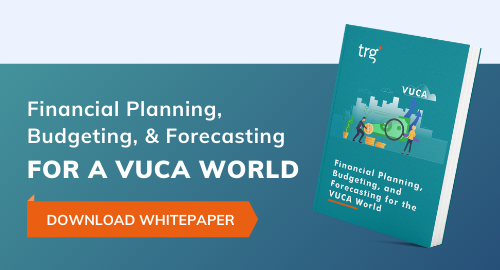By definition, forecasting is the process of prediction or evaluation of the upcoming events, trends, outcomes, etc. For business prospects, simply guessing what future might hold is very risky and not appropriate for the most. That’s how annual budgeting plans came to be. Although, even with the best data and tools, the business climate is very unpredictable and ever-changing. To fight budget uncertainty, Rolling Forecast is here to save the day.

What is rolling forecasting?
Rolling forecast is a dynamic approach to financial planning and reporting. It allows companies to adapt their budgeting plan according to actual results in real-time. In words of Paul Saffo, Silicon Valley technology forecaster, “the goal of forecasting is not to predict the future, but to tell you what you need to know to take meaningful action in the present.” Rolling forecast versatility allows the management to take action when needed.
The popularity soared from the 2008 financial crisis when many companies dropped the annual budgeting in favour of the rolling forecast. Today, it is estimated that around 60% of top-performing companies are using it, at least as an addition to the annual budgeting process if not using it exclusively.
Fortune 500 corporations such as Southwest Airlines (the world’s largest low-cost carrier) or Equinor (9th largest oil company in the world) use rolling forecast for their budgeting.
Read more: How Machine Learning Is Guiding These Top 5 Companies to Success
Benefits of rolling forecast
Why use it in the first place? The simple answer would be to navigate through turbulent times and changing business conditions. The current pandemic with its new health guidelines is the perfect example. This sudden shift for the markets influenced operational incomes, expenses, overheads, investments and annual plans became obsolete very early on this year. To make matters even worse, it is still hard to predict the situation for the upcoming months.
Companies that implemented a rolling forecast perform better than competitors. IBM conducted research focusing on companies using rolling forecast, and data shows:
- 14% increase in forecast accuracy
- 33% decrease in preparation time
- 50% improvement in revenue
- 300% improvement in productivity
From more accurate planning, better risk management to increased efficiency, rolling forecast gives the decision-makers the power to steer organisations towards a more desirable future. It is a consistent evaluation of data coming from the day to day life of the organisation, which (if used right) can help improve organisational performance in the future.
Read more: Financial Planning vs Budgeting vs Forecasting: A Quick Comparison
How rolling forecast works
How is it different from regular fixed annual or quarterly budgeting?
While regular static projections are set for a specific year or quarter (for example, year 2020 or Q4/2019), rolling forecast is set for a particular time range, such as six or 12 months.
For example, if the annual resources plan is set for this year, in August, eight months passed and four more months are remaining until the end of 2020, and then stops. On the other side, rolling forecast for 12 months at the same time will be updated until September of 2021, always providing an outlook for the next 12 months no matter what month or quarter it is. The idea is with each passing month, the new one will be added, and the forecast is always rolling on forward.
How to create a rolling forecast
Type of forecast can be different based on the type of business, size of operations, model, etc. In general, there are a few universal rules to follow in order to achieve successful implementation.
1. Define the goals
The objective of the rolling forecast must be explicitly defined. What should be the intention for the rolling forecast? Why is the organisation executing it? Will the Rolling Forecast replace the annual budget method or work alongside it? These questions must be answered, and understanding must be reached within the company.
Also, the forecast itself should not be confused for the business target, because while the target is more of aspiration, the forecast is an exposition of future direction based on the actual data.
Read more: Kempinski Hotels financial forecast case study
2. Define the time window
It is essential to consider how long the time window for the rolling forecast should be. Weeks, months or even years ahead? If it is too long, while it may render more useful long-term insights, it will be less accurate and precise, because a lot can change in that time frame.
Also, an important thing to consider is how frequently rolling forecasts should be refreshed. Will it be on a weekly, monthly, quarterly or yearly basis? It is highly individual to the individual organisation, as some smaller companies with limited human resources can be fine with monthly or quarterly updated forecasts. At the same time, some corporations could require greater granularity with weekly updates.
Infographic: 4 Tips for CFOs to Help Improve Sales Forecasting
3. Define the level of details
Similar to the point before, it depends on the business of how detailed the estimate must be. Suppose the company can make decisions on general operation finances such as sales and price of the product. In that case, the collection of extreme details may be contra-productive, as more time is invested in the compilation of data and processing than analysis and relevant conclusions.
Although the size of the data pool may not always need to be large, the level of accuracy must be high by any means. Decision-based on incorrect data can be devastating for a business of any size.
Read more: How Cloud Computing Benefit Small and Medium-sized Companies
4. Define the drives
Tracking every performance metric of the organisation for the rolling forecast may be unnecessary. It is essential to find what the value drivers for the organisation are and break them down. What is going to make a difference in the grand scope of things, such as market share, overall growth, talent acquisition, sales and others. The recent increase in market share can influence the budget for the upcoming months more than the last monthly invoice for office supplies.
Similar applies to tracking and calculating just profits and expenses. Does it tell the whole story? For instance, a manufacturer may be able to control the yearly revenue as much as it may control the price of its products, contribution margin or amount of units produced. Find what is essential for the organisational success, as that is the driver of the value and focus on it.
5. Define possible scenarios
The benefit of rolling forecast is that it can be built around different business scenarios, also known as “what-if” analysis. The key is to be prepared for the positive trend, as well as a negative one. Even if actual results end up somewhere in between, it was expected to some degree.
Scenarios may vary, from market decline, increase in taxation or situations where global crisis takes place. Be prepared for these types of scenarios can make a difference in how useful the rolling forecast could be for the company. Forecast for the best, forecast for the worst, and be unsurprised by anything in between.
6. Evaluation of results
When the latest results are in, variance analysis shows how precise the estimate was. It is an analysis of the difference between the plan and the reality. Reflection on stats and understanding why there is the percentage difference can help to improve prediction of future outcomes and make forecasting even more realistic. After all, reliable forecasts bring a sense of stability in ever-uncertain business life.
Read more: What Does the Future Hold for Financial Forecasting?
 English
English  Vietnamese
Vietnamese 


